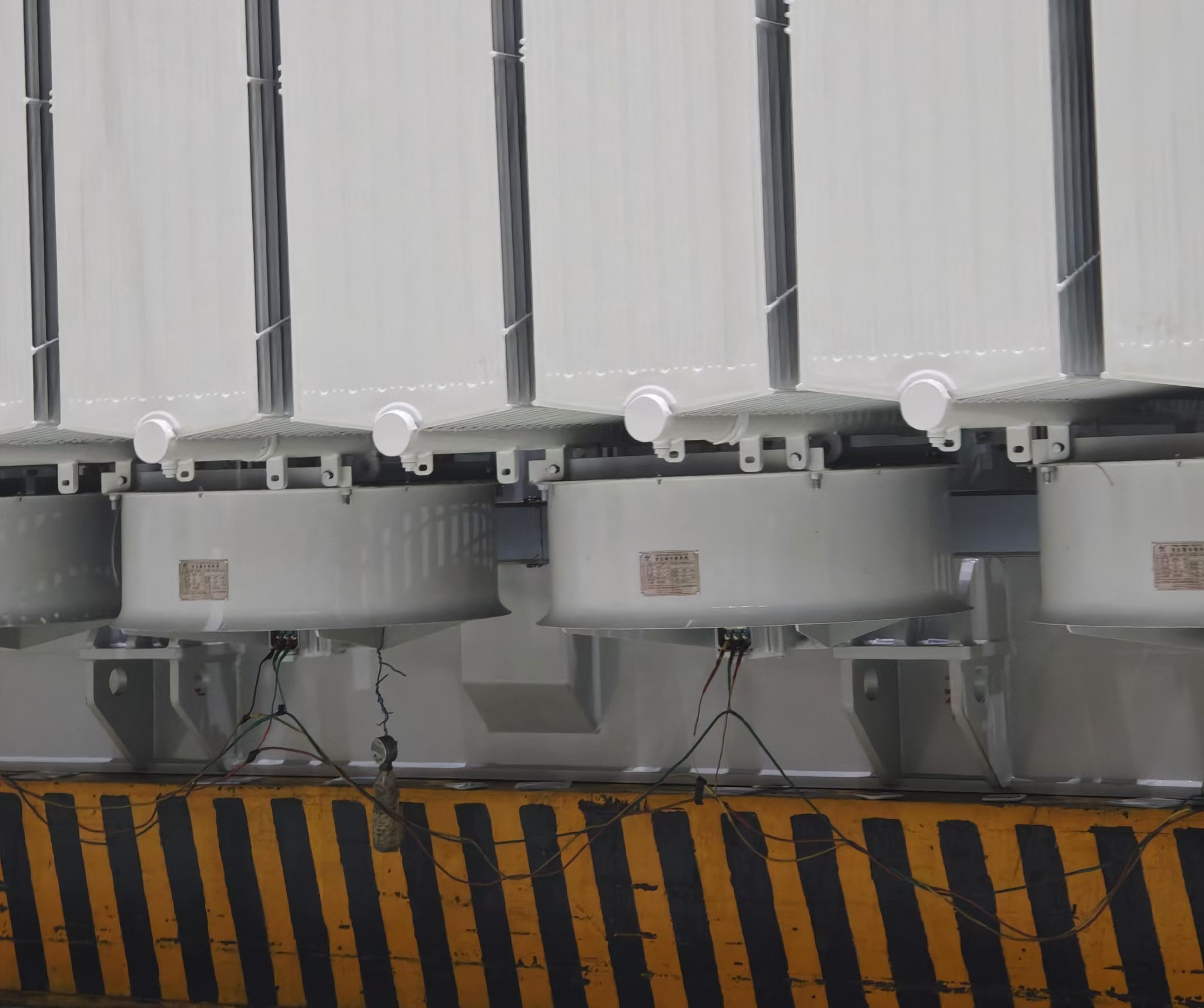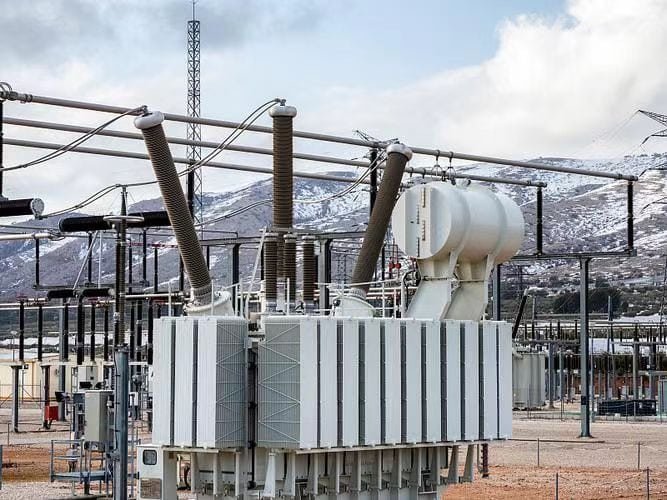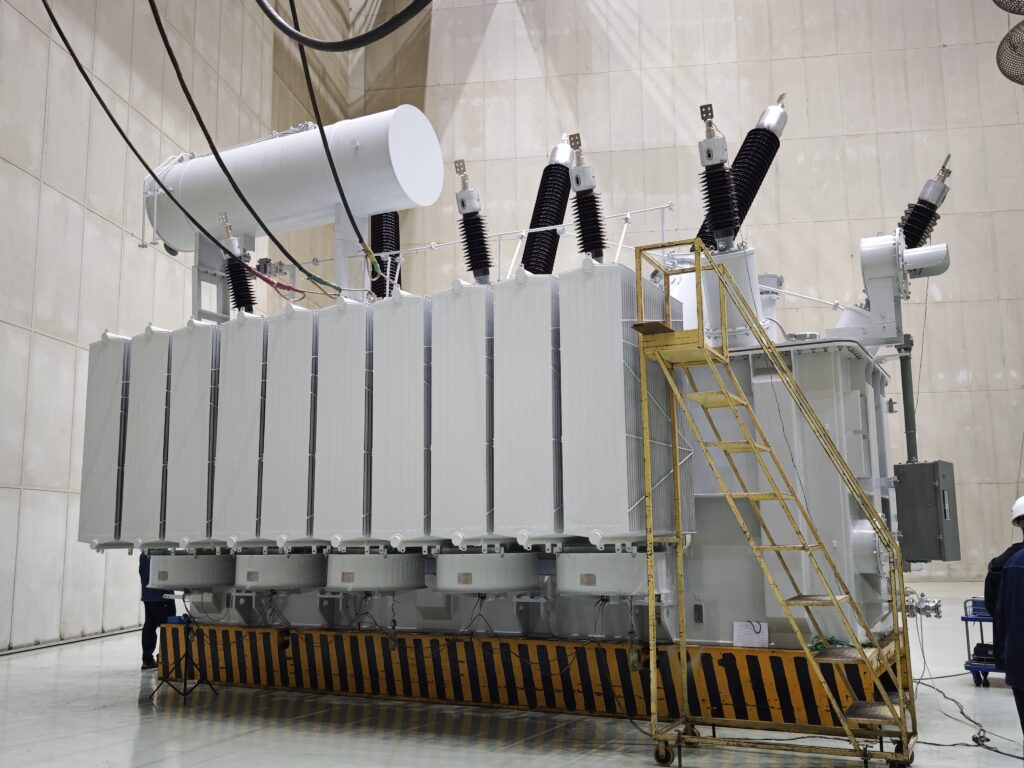In transformer cooling classification, abbreviations such as AN, AF, ONAN, ONAF, OFAF, and others are commonly used to describe the method of cooling applied to the transformer. Among these, AF stands for Air Forced, which means that the transformer is cooled by external fans that force air circulation over the windings or core to enhance heat dissipation. Understanding AF cooling is essential for evaluating transformer performance, efficiency, and suitability for specific applications.
What Does AF (Air Forced) Mean in Transformer Cooling?

When it comes to power transformers, efficient cooling is one of the most critical factors to ensure safety, reliability, and long service life. Without proper cooling, the insulation degrades faster, the oil or winding temperature rises, and the risk of catastrophic failure increases. Many customers, engineers, and technicians are often confused by abbreviations like ONAN, ONAF, or AF. Among these, AF (Air Forced) often raises questions, especially regarding its role in transformer cooling. If this concept is not clearly understood, it can lead to design mistakes, operational issues, or misinterpretation of a transformer's thermal performance. The good news is that once we understand the principle behind AF, choosing the right cooling method becomes straightforward.
AF (Air Forced) in transformer cooling means that external fans are used to blow air across the cooling surfaces, such as radiators or fins, to accelerate the heat dissipation process. Unlike natural air cooling, which relies on ambient airflow, AF actively forces air circulation, improving the cooling efficiency, reducing hotspot temperatures, and increasing the transformer’s loading capacity.
This is an important concept because transformer loading directly depends on cooling efficiency. Without active air-forced cooling, many transformers would have to operate at reduced loads, which is economically inefficient. With AF, transformers can safely handle higher loads, maintain lower winding and oil temperatures, and extend service life. Let’s dive deeper into how AF works, its applications, advantages, technical details, and comparisons with other cooling methods.
AF cooling in transformers is the same as ONAN cooling.False
AF cooling involves forced air circulation using fans, while ONAN relies only on natural air movement without fans.
Forced air cooling in transformers allows higher load handling capacity compared to natural cooling.True
By actively blowing air over the cooling surfaces, AF lowers transformer temperature and permits higher rated load without overheating.
Understanding Transformer Cooling Methods
Transformer cooling systems are generally categorized using standardized IEC/IEEE codes. The abbreviations indicate the type of cooling medium and circulation method:
| Code | Full Form | Description | Typical Application |
|---|---|---|---|
| ONAN | Oil Natural Air Natural | Oil circulates naturally, heat dissipates by ambient air without fans | Small/medium distribution transformers |
| ONAF | Oil Natural Air Forced | Oil circulates naturally, but fans force air across radiators | Medium/large power transformers |
| OFAF | Oil Forced Air Forced | Oil is pumped, and air is blown by fans | High-capacity transformers |
| AF | Air Forced | Air is blown across dry-type transformer windings or surfaces | Dry-type transformers, indoor substations |
| AN | Air Natural | Air circulates naturally, without fans | Dry-type, low-capacity transformers |
From this classification, AF is most commonly associated with dry-type transformers, where no oil medium exists. Instead, fans directly blow air across windings and insulation systems to control heat rise.
Technical Working Principle of AF Cooling
In an AF-cooled transformer, forced air is directed by fans over the transformer's cooling fins, windings, or radiators. The increased airflow:
- Enhances convection heat transfer
- Lowers hot-spot temperatures by 10–15°C compared to natural cooling
- Reduces thermal aging of insulation
- Enables higher load cycles (often 25–40% above natural cooling rating)
Here’s a comparison of Air Natural (AN) vs. Air Forced (AF):
| Parameter | AN Cooling | AF Cooling |
|---|---|---|
| Cooling method | Natural convection | Forced airflow via fans |
| Load handling | Normal rating | 25–40% higher rating |
| Cost | Lower | Higher (fans + controls) |
| Maintenance | Minimal | Requires fan maintenance |
| Noise level | Very low | Higher due to fan operation |
| Applications | Small dry-type | Large dry-type, industrial, substations |
Applications of AF Cooling in Transformers
- Dry-Type Transformers in Indoor Substations – where fire risk prevents the use of oil cooling.
- Industrial Installations – heavy-duty applications like steel plants, data centers, and metro stations demand higher transformer load capacities.
- Renewable Energy Systems – wind and solar power step-up transformers where compact design and overload handling are essential.
- Critical Infrastructure – hospitals, airports, and metros where reliability and compactness are prioritized.
Benefits and Challenges of AF Cooling
Advantages:
- Increases transformer capacity without changing core/winding size.
- Improves insulation life by keeping hot-spot temperature lower.
- Flexible operation – fans can be switched on during peak load only.
Challenges:
- Higher operating noise (fans).
- Regular maintenance of fan motors and bearings.
- Higher initial cost compared to natural cooling.
Case Example – Load Capacity Increase with AF
A 2000 kVA dry-type transformer with natural air cooling (AN) can typically operate continuously at its rated load. When AF cooling is applied, forced fans increase the load capacity up to 2500–2700 kVA for short durations without exceeding thermal limits. This is a significant advantage in urban substations where upgrading transformer size is impossible due to space restrictions.
Long-Term Performance Considerations
For maximum reliability:
- Install temperature sensors (PT100 or fiber optic) in windings to monitor real-time heat rise.
- Use automatic fan control systems that activate fans only when temperatures exceed preset thresholds.
- Maintain fan redundancy to ensure continuous cooling in case of failure.
How Does AF Cooling Differ from AN (Air Natural) Cooling?
Cooling plays a decisive role in transformer efficiency, reliability, and service life. In dry-type transformers, the most common cooling methods are Air Natural (AN) and Air Forced (AF). Selecting the wrong cooling system for a given application can result in overheating, accelerated insulation aging, and unexpected failures, especially under high or fluctuating loads. By contrast, choosing the right method ensures stable operation, longer life, and compliance with safety standards.
Air Natural (AN) cooling relies on natural convection and radiation to dissipate heat, requiring no moving parts, while Air Forced (AF) cooling uses fans or blowers to increase airflow across windings and the core, significantly boosting heat dissipation. AF cooling provides higher load capacity and thermal stability but requires additional equipment, power consumption, and maintenance.
Many engineers and operators hesitate between AN and AF, particularly when upgrading systems or working in outdoor installations. Let us compare both methods in depth.
Air Natural (AN) cooling can handle higher loads than Air Forced (AF) cooling.False
AF cooling significantly increases airflow, enhancing heat dissipation and allowing higher load capacity compared to AN cooling.
Air Forced (AF) cooling requires periodic maintenance of fans and filters, unlike AN cooling which is almost maintenance-free.True
AN relies only on natural convection, while AF uses mechanical fans that require inspection and replacement.
1. Principle of Operation
Air Natural (AN):
- Heat is removed through natural convection.
- Warm air rises naturally around windings and escapes through ventilation ducts.
- Cooling is passive, silent, and requires no auxiliary power.
Air Forced (AF):
- Fans or blowers push cool air into transformer windings.
- Heat removal is active, enhancing thermal conductivity.
- Cooling capacity adapts to higher load or hot climates.
📊 Illustration:
- AN = 100% base cooling capacity.
- AF = 130–150% of AN capacity (varies by design).
2. Efficiency and Load Capacity
| Parameter | AN Cooling | AF Cooling |
|---|---|---|
| Cooling Mechanism | Natural convection | Forced convection (fans) |
| Load Capacity | Standard (rated load) | Higher (up to 130–150%) |
| Efficiency Impact | Stable at nominal load | Improved under overload |
| Auxiliary Power | None | Required for fans |
3. Maintenance and Reliability
AN Cooling:
- Virtually maintenance-free.
- No moving parts → high reliability.
- Ideal for remote or low-maintenance sites.
AF Cooling:
- Requires fan inspections, cleaning, and filter replacement.
- Slightly higher failure probability due to mechanical parts.
- Critical for high-load applications despite added maintenance.
📊 Case Study: A chemical plant upgraded from AN to AF cooling to handle 40% higher peak loads, but added a quarterly fan inspection program to prevent unexpected failures.
4. Application Scenarios
| Application Type | Preferred Cooling | Reason |
|---|---|---|
| Indoor, stable loads | AN | Simplicity, low noise, minimal maintenance |
| Outdoor, dusty/hot zones | AF with filters | Extra cooling to handle climate and overload |
| Industrial with variable load | AF | Handles load spikes effectively |
| Remote areas | AN | High reliability, no fan maintenance required |
5. Standards and Classifications
- IEC 60076-11: Defines AN, AF, ANAF (AN + AF combined), AFAF (dual-stage AF).
- IEEE C57.12.01: Specifies cooling class labeling for dry-type transformers.
When Is AF Cooling Used in Transformers?

Outdoor and industrial transformers often face high loads, fluctuating demand, and extreme ambient temperatures. Under these conditions, natural cooling alone may not be enough to keep the transformer within safe operating limits. Without additional cooling, operators risk overheating, reduced insulation life, and unexpected shutdowns. AF cooling provides the solution by actively enhancing heat dissipation and allowing transformers to carry higher loads safely.
AF cooling (Air Forced cooling) is used in transformers when natural convection (AN cooling) is insufficient, such as during high load demands, hot climates, or environments with restricted airflow. By using fans or blowers to force air circulation across windings and the core, AF cooling increases heat dissipation, supports higher load capacity (up to 130–150% of AN rating), and ensures stable performance under varying operating conditions.
While AN cooling is ideal for light to moderate loads and stable environments, AF becomes essential where performance, safety, and load flexibility are priorities.
AF cooling is only needed in extremely large transformers.False
AF cooling is used in small to large transformers when loads, climate, or ventilation limits exceed the capacity of AN cooling.
AF cooling allows a transformer to safely operate above its natural cooling rating.True
By forcing airflow, AF cooling increases thermal dissipation and permits higher load operation without overheating.
1. Situations That Require AF Cooling
High Load Demands:
- Industrial facilities with peak loads exceeding AN limits.
- Transformers supporting motor start-ups or fluctuating processes.
Hot Climates:
- Environments where ambient temperatures stay high, limiting natural convection.
- AF cooling keeps operating temperatures stable despite external heat.
Limited Ventilation:
- Indoor substations or confined spaces where air cannot circulate freely.
- Fans ensure active airflow to remove trapped heat.
Overload Conditions:
- Temporary or emergency overloads in utility networks.
- AF cooling provides thermal margin and prevents insulation breakdown.
📊 Performance Example: A 2,000 kVA dry-type transformer in a steel plant operates at 1,300 kVA under AN cooling. With AF cooling engaged, it safely handles 1,800 kVA, extending operational flexibility without oversizing equipment.
2. Advantages of AF Cooling
| Factor | AN Cooling | AF Cooling |
|---|---|---|
| Load Capacity | Nominal | 130–150% of nominal |
| Auxiliary Power | None | Fans consume small power (1–2% of load) |
| Maintenance | Minimal | Requires fan/filter inspection |
| Reliability | Very high | Slightly lower (fan failures possible) |
| Noise Level | Silent | Higher (fan noise) |
3. Common Applications
- Industrial Sites: Cement, steel, chemical, and mining facilities.
- Renewable Energy: Wind and solar farms where load fluctuates rapidly.
- Urban Substations: Compact designs with limited natural airflow.
- Outdoor Harsh Climates: Hot desert or tropical areas where AN is insufficient.
4. Standards Covering AF Cooling
- IEC 60076-11: Defines cooling classifications (AN, AF, ANAF, AFAF).
- IEEE C57.12.01: Specifies ventilation and cooling requirements for dry-type transformers.
What Are the Advantages and Limitations of AF Cooling?
Transformers generate significant heat during operation, and inadequate cooling can cause insulation deterioration, efficiency losses, and shortened lifespan. For dry-type and some oil-immersed units, Air Forced (AF) cooling is applied to boost cooling capacity when natural air convection (AN) alone cannot handle heat dissipation. While AF cooling offers major benefits in terms of performance and load flexibility, it also introduces additional maintenance requirements, operational costs, and reliability risks.
The main advantages of AF cooling are increased load capacity (up to 130–150% of AN rating), better heat dissipation in hot climates or confined spaces, and enhanced flexibility for fluctuating loads. Its limitations include fan power consumption, higher noise levels, increased maintenance needs (cleaning, inspections, filter replacements), and the risk of fan failure leading to overheating.
AF cooling increases the transformer’s effective load capacity beyond AN cooling.True
By forcing airflow across windings and the core, AF cooling enhances heat transfer and supports higher operational loads.
AF cooling requires no maintenance since it only adds airflow.False
Fans, filters, and ducts require regular inspection, cleaning, and replacement to ensure reliable operation.
1. Advantages of AF Cooling
Higher Load Capacity:
- Allows transformers to operate above their AN-rated loads.
- Commonly increases capacity by 30–50%.
Improved Thermal Stability:
- Keeps winding and insulation temperatures within safe limits.
- Extends insulation life compared to AN-only operation.
Flexibility in Harsh Environments:
- Essential in hot climates, urban substations, or industrial sites with fluctuating loads.
- Compensates for restricted airflow in compact enclosures.
Optimized Equipment Sizing:
- Reduces the need to oversize transformers for rare peak loads.
- Provides temporary overload capacity at lower capital investment.
📊 Example: A 2,500 kVA dry-type transformer designed for AN operation at rated load can handle 3,300 kVA with AF cooling engaged, ensuring uptime during peak hours without oversizing equipment.
2. Limitations of AF Cooling
Auxiliary Power Requirement:
- Fans consume additional energy (typically 1–2% of transformer load).
- Slightly reduces net efficiency.
Maintenance Needs:
- Fans, ducts, and filters must be inspected and cleaned regularly.
- Increased probability of cooling failure if neglected.
Reduced Reliability Compared to AN:
- Moving parts introduce failure risks.
- Fan breakdown during high load could trigger overheating or trips.
Noise Generation:
- Fans increase operating noise, requiring mitigation in residential or quiet zones.
📊 Comparison Table:
| Factor | Air Natural (AN) | Air Forced (AF) |
|---|---|---|
| Load Capacity | Rated | 130–150% of rated |
| Auxiliary Power | None | Required for fans |
| Maintenance | Minimal | Moderate (fans/filters) |
| Reliability | Very high | Slightly lower (moving parts) |
| Noise | Silent | Moderate (fan noise) |
| Best Use Case | Stable loads, mild climates | High/variable loads, hot/dusty climates |
3. Standards and Recommendations
- IEC 60076-11 and IEEE C57.12.01 classify cooling methods (AN, AF, ANAF, AFAF).
- Best practice: Use AF cooling with temperature monitoring systems to activate fans only when needed, reducing noise, energy use, and wear.
Conclusion
AF in transformers refers to Air Forced cooling, where fans are used to improve airflow and cooling efficiency. This method allows transformers to handle higher loads compared to natural air cooling, making it suitable for demanding industrial and commercial applications. However, it also introduces additional complexity, dependency on fans, and slightly higher maintenance requirements. Proper selection between AN and AF depends on load demands, installation environment, and reliability requirements.
FAQ
Q1: What does AF mean in a transformer?
AF stands for Air Forced cooling. It refers to a cooling method where external fans blow air over the transformer windings or enclosure to improve heat dissipation, ensuring safe operation under higher loads.
Q2: How does AF cooling differ from AN cooling?
AN (Air Natural): Cooling relies on natural air convection without fans.
AF (Air Forced): Uses fans to force air circulation, increasing cooling efficiency and allowing the transformer to handle higher load capacity compared to AN.
Q3: In which transformers is AF cooling commonly used?
AF cooling is commonly applied in dry type transformers, cast resin transformers, and in situations where load fluctuations demand additional cooling capacity. It is widely used in commercial buildings, data centers, and industrial applications.
Q4: What are the benefits of AF cooling?
Increased thermal capacity allowing temporary overloads.
Improved longevity of insulation due to reduced temperature rise.
Enhanced reliability and safety in high-demand environments.
Q5: What are the limitations of AF cooling?
Dependence on fans means failure of fan systems can lead to overheating.
Requires additional maintenance (cleaning, fan checks, motor servicing).
Generates higher noise levels compared to natural cooling.
References
IEEE C57 – Transformer Cooling Classifications: https://ieeexplore.ieee.org
IEC 60076 – Transformer Cooling Methods Standard: https://webstore.iec.ch
Electrical4U – Transformer Cooling Types Explained: https://www.electrical4u.com
EEP – Transformer Cooling Systems Guide: https://electrical-engineering-portal.com
NEMA – Transformer Cooling Standards: https://www.nema.org
Doble Engineering – Transformer Thermal Management: https://www.doble.com


